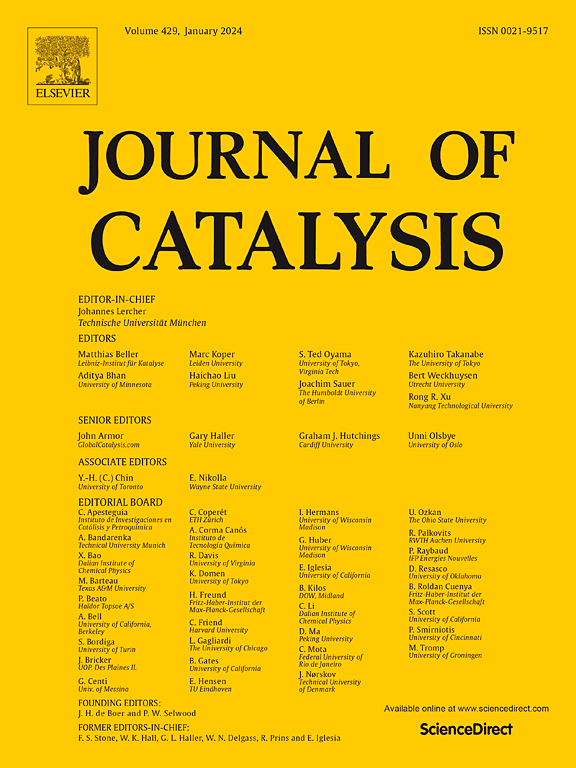从静态照明切换到周期性照明时硝基芳烃光催化转移加氢的机理交叉
IF 6.5
1区 化学
Q2 CHEMISTRY, PHYSICAL
引用次数: 0
摘要
许多研究已经证明了控制周期性照明在提高非均相光催化反应的量子效率方面的潜力。然而,增强效应的本质仍然存在争议。在这里,我们报道了通过周期性光照促进hcooh介导的4-硝基苯酚加氢在Pd/TiO2上的光催化活性。12 Hz的周期性光照导致4-硝基酚转化率与占空比之间的非单调关系,占空比为10 %时氨基酚收率提高2.4倍。然而,随着占空比的增加,光催化活性的改善逐渐减弱,最终在占空比超过50% %时停止。进一步探索当前设置的操作极限,我们观察到4-硝基苯酚加氢活性的最大增强为3.4倍,相当于量子产率提高了40倍。同时H2析出速率和pH对氨基苯酚产率的影响表明,Pd纳米颗粒上H*的减少有助于4-硝基苯酚的吸附。我们假设这种表面种群的差异导致了两种不同的动力学主导反应机制之间的交叉。动力学和Pd中毒研究证实,在静态和周期性照明下,占空比高于50% %时,高H*导致主导离子途径。相反,低占空比的周期性光照有利于4-硝基苯酚的吸附和随后的H*加成。本文章由计算机程序翻译,如有差异,请以英文原文为准。


Mechanistic crossover in photocatalytic transfer hydrogenation of nitroaromatics upon switching from static to periodic illumination
Numerous studies have demonstrated the potential of controlled periodic illumination in improving the quantum efficiency of heterogeneous photocatalytic reactions. However, the nature of the enhancement effect remains debated. Here, we report the promotion in photocatalytic activity of HCOOH-mediated 4-nitrophenol hydrogenation over Pd/TiO2 via periodic illumination. Periodic illumination at 12 Hz led to a non-monotonic relationship between 4-nitrophenol conversion as a function of duty cycle, with 2.4 times enhancement in aminophenol yield at 10 % duty cycle. However, the improvement in photocatalytic activity was progressively diminished with increasing duty cycles and eventually discontinued at duty cycles above 50 %. Further exploring the operating limits of the current setup, we observed a maximum enhancement in 4-nitrophenol hydrogenation activity of 3.4-fold equivalent to 40-fold increase in quantum yield. Evaluation of simultaneous H2 evolution rates and the effects of pH on aminophenol yield suggest that reduced amount of H* on the Pd nanoparticles contributes to 4-nitrophenol adsorption. We hypothesize that this difference in surface population leads to a crossover between two different kinetically dominant reaction mechanisms. Substantiated by kinetic and Pd poisoning studies, high H* under static and periodic illumination at duty cycles above 50 % leads to a dominant ionic pathway. In contrast, periodic illumination at lower duty cycles favors 4-nitrophenol adsorption and subsequent H* addition.
求助全文
通过发布文献求助,成功后即可免费获取论文全文。
去求助
来源期刊

Journal of Catalysis
工程技术-工程:化工
CiteScore
12.30
自引率
5.50%
发文量
447
审稿时长
31 days
期刊介绍:
The Journal of Catalysis publishes scholarly articles on both heterogeneous and homogeneous catalysis, covering a wide range of chemical transformations. These include various types of catalysis, such as those mediated by photons, plasmons, and electrons. The focus of the studies is to understand the relationship between catalytic function and the underlying chemical properties of surfaces and metal complexes.
The articles in the journal offer innovative concepts and explore the synthesis and kinetics of inorganic solids and homogeneous complexes. Furthermore, they discuss spectroscopic techniques for characterizing catalysts, investigate the interaction of probes and reacting species with catalysts, and employ theoretical methods.
The research presented in the journal should have direct relevance to the field of catalytic processes, addressing either fundamental aspects or applications of catalysis.
 求助内容:
求助内容: 应助结果提醒方式:
应助结果提醒方式:


